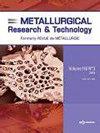用响应面法研究增量板成形工艺参数的影响
IF 0.9
4区 材料科学
Q3 METALLURGY & METALLURGICAL ENGINEERING
引用次数: 3
摘要
金属成形的新方法正在迅速发展,并采用了几种成形工艺来优化制造部件和降低生产成本。单点增量成形(SPIF)是一种用于快速成型应用和小批量生产的金属板材成形工艺。这项工作致力于研究截形金字塔的轮廓几何和厚度演变。研究了SPIF过程中工艺参数的影响。采用数值响应面法和试验设计(DOE)来改善减厚和回弹效果。通过改变四个参数:刀具直径、成形角度、板材厚度和刀具路径,执行了一组16个测试。采用Gurson-Tvergaard-Needleman (GTN)损伤模型分析材料变形过程中的损伤演化。结果表明,该模型能有效地预测工件的几何轮廓和厚度,误差小于4%。此外,还发现成形角是影响减厚和回弹水平的最主要参数。最后,分析了成形角对损伤演化的影响。本文章由计算机程序翻译,如有差异,请以英文原文为准。
Investigation of the influence of incremental sheet forming process parameters using response surface methodology
New methods in metal forming are rapidly developing and several forming processes are used to optimize manufacturing components and to reduce cost production. Single Point Incremental Forming (SPIF) is a metal sheet forming process used for rapid prototyping applications and small batch production. This work is dedicated to the investigation of the profile geometry and thickness evolution of a truncated pyramid. The influence of process parameters during a SPIF process is also studied. A numerical response surface methodology with a Design of Experiments (DOE) is used to improve the thickness reduction and the effects of the springback. A set of 16 tests are performed by varying four parameters: tool diameter, forming angle, sheet thickness, and tool path. The Gurson-Tvergaard-Needleman (GTN) damage model is used to analyze the damage evolution during material deformation. It is found that the model can effectively predict the geometrical profile and thickness with an error of less than 4%. Furthermore, it is noticed that the forming angle is the most influential parameter on the thickness reduction and springback level. Finally, the damage evolution is demonstrated to be sensitive to the forming angle.
求助全文
通过发布文献求助,成功后即可免费获取论文全文。
去求助
来源期刊

Metallurgical Research & Technology
METALLURGY & METALLURGICAL ENGINEERING-
CiteScore
1.70
自引率
9.10%
发文量
65
审稿时长
4.4 months
期刊介绍:
Metallurgical Research and Technology (MRT) is a peer-reviewed bi-monthly journal publishing original high-quality research papers in areas ranging from process metallurgy to metal product properties and applications of ferrous and non-ferrous metals and alloys, including light-metals. It covers also the materials involved in the metal processing as ores, refractories and slags.
The journal is listed in the citation index Web of Science and has an Impact Factor.
It is highly concerned by the technological innovation as a support of the metallurgical industry at a time when it has to tackle severe challenges like energy, raw materials, sustainability, environment... Strengthening and enhancing the dialogue between science and industry is at the heart of the scope of MRT. This is why it welcomes manuscripts focusing on industrial practice, as well as basic metallurgical knowledge or review articles.
 求助内容:
求助内容: 应助结果提醒方式:
应助结果提醒方式:


